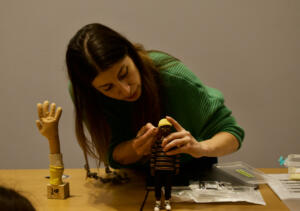The Pro Talks

Effie Pappa, the director and animator who participated this year with her fantastic film "Boss Level Nerves" and ran the educational program “From Paper to Life,” talks to us about animation, her unique journey in cinema, and shares her insights!
What advice would you give to someone in Greece considering pursuing studies like yours?
If you want my honest opinion? No career path guarantees success—none at all. Even becoming a doctor, lawyer, or architect, which are often considered “safe” choices, doesn’t ensure that you’ll find what you’re looking for, as even those fields are oversaturated. What I always say is that my “guiding star” is my instinct, my desire to do something I truly love and enjoy. Choosing a profession is a decision that will accompany you for life—it becomes part of who you are. Since it’s something you’ll do every day, it would be a shame not to pursue something you genuinely enjoy. For me, animation was an incredible challenge to create something unique, and it’s not an oversaturated profession. My advice? Follow what makes you happy and listen to your instincts.
What exactly did you study?
Initially, I studied graphic design because, at the time, I didn’t even know animation existed, let alone what it entailed or how it was done. I knew I liked working with my hands and wasn’t interested in architecture, so I chose graphic design, which also involved drawing. During my studies, there was a class on animation that combined illustration and comics, and I decided to try it out since I had no idea what it was or how it worked—I wanted to learn. I tried it, and you know what happened? I wanted more! At the same time, I was involved in amateur theater when I was younger, and I loved anything related to storytelling, acting, and narrative. That’s how I found animation—it allowed me to do everything I loved: making films, working with my hands, and combining it all with sound. That was it!
Was it difficult to establish your career?
Not really! I’m a freelancer, and like any small or large business, there are ups and downs depending on the circumstances. For example, when there wasn’t much demand for commercials, the entire industry faced challenges, and so did I. However, because my work is specialized and unique, there’s not as much competition. I also try to share my love for animation and encourage more people to get involved in the field.
What are the best animation schools in Europe?
It depends on the type of animation you want to do. If you’re interested in technical animation, France has amazing schools. The UK also has some fantastic programs. The school I attended, the National Film and Television School, is considered one of the best. However, it focuses more on narrative aspects rather than teaching the technical side of animation, assuming you already have that knowledge. Instead, it emphasizes directing. So, I’d say France and the UK have excellent departments.
At the workshop you ran as part of the Festival, you highlighted the great atmosphere that emerges when a team has many members. How did you build your own team?
First of all, the good thing is that the animation industry is still relatively small, so we all kind of know each other. I’ve met most of the people I work with through various festivals. For example, when you attend the same festivals each year, you start meeting other creators, and it fosters a friendly and supportive atmosphere.
At one exhibition, I met a model maker who I now work with constantly. She came to the exhibition out of curiosity, introduced herself, later worked for me for a while, and did an incredible job. Now we’re inseparable. Sometimes, if I see a piece of work I admire, I’ll call the creator to collaborate—it can happen like that too.
Do you think a director working in animation needs additional skills compared to a director of conventional films?
What a director needs most is vision. They need to have a clear idea of what the film will look like, how the characters will behave, and what kind of world they’ll inhabit. Every director has their own unique perspective—how they’ll use colors, textures, and what emotions they want to evoke. Then they must be able to communicate all of this to the other departments working on the film.
Take my film as an example. I wanted Maura, the protagonist, to be someone with insecurities. We used this as a central element because it adds sensitivity to her character and the story. I also wanted it to be clear that she hires people from diverse cultural backgrounds and is a character with empathy. This sensitivity and inclusiveness were central themes that shaped all our creative decisions. A director needs to have a comprehensive vision and know their characters inside and out.
Do you feel a connection to your protagonist, given that you also run your own business?
I’d say yes! I face all the challenges that come with running a small business, just like she does.